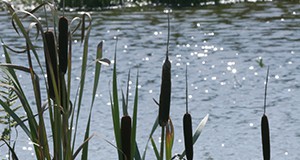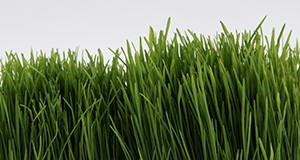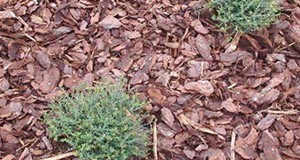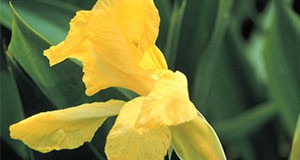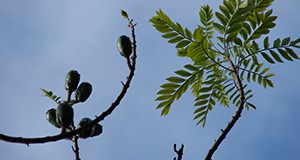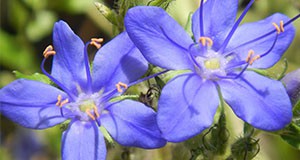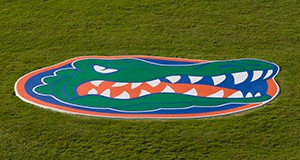
In many neighborhoods, people envy the individual with the most beautiful lawn and think they cannot grow a lawn of equal quality. That is not necessarily true. A well-maintained lawn only requires some knowledge about fertilization, watering, pest control, and mowing. This publication provides basic information about fertilization. By far, the best approach to a proper fertilization program is to start with a soil test, but, if a soil test is not available, these guidelines can be used for a general turfgrass fertilization program. Original publication date May 1991. Revised August 2013 and August 2015.
http://edis.ifas.ufl.edu/lh014
Category: Lawn & Garden
Strategies to Encourage Adoption of Stormwater Pond Best Management Practices (BMPs) by Homeowners
Man-made ponds can be a useful way to collect, store, and treat stormwater runoff in residential areas. However, these ponds can become polluted when runoff contains fertilizers, pesticides, and pet waste from the neighborhood. This 8-page fact sheet outlines several best management practices (BMPs) for reducing stormwater pond pollution. Based on a survey of residents who live near stormwater ponds, the authors recommend strategies Extension educators can use to encourage residents to adopt these BMPs. Written by Emily Ott, Paul Monaghan, Ondine Wells, Gail Hansen, Laura Warner, and Michelle Atkinson, and published by the UF Department of Agricultural Education and Communication, July 2015.
http://edis.ifas.ufl.edu/wc214
Pillbug, Roly-Poly, Woodlouse Armadillidium vulgare (Latreille) (Malacostraca: Isopoda: Armadillidiidae)
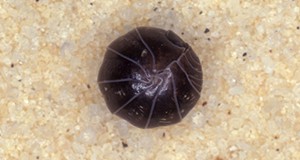 The roly poly is an isopod, a type of non-insect arthropod also known as a terrestrial crustacean. It is called a roly-poly because it rolls into ball when disturbed. This defensive behavior also makes it look like a pill, which is why it is sometimes called a pillbug. In Europe, the name woodlouse is used for both roly polies and sowbugs because these arthropods are frequently found under logs. Roly polies are nocturnal, though they may be found during the day in the soil or under debris. They are beneficial in the garden or landscape. This 3-page fact sheet about the humble roly poly was written by Julie A. Franklin, Morgan A. Byron, and Jennifer Gillett-Kaufman and published by the UF Department of Entomology and Nematology, August 2015. (Photo by James Castner, University of Florida)
The roly poly is an isopod, a type of non-insect arthropod also known as a terrestrial crustacean. It is called a roly-poly because it rolls into ball when disturbed. This defensive behavior also makes it look like a pill, which is why it is sometimes called a pillbug. In Europe, the name woodlouse is used for both roly polies and sowbugs because these arthropods are frequently found under logs. Roly polies are nocturnal, though they may be found during the day in the soil or under debris. They are beneficial in the garden or landscape. This 3-page fact sheet about the humble roly poly was written by Julie A. Franklin, Morgan A. Byron, and Jennifer Gillett-Kaufman and published by the UF Department of Entomology and Nematology, August 2015. (Photo by James Castner, University of Florida)
http://edis.ifas.ufl.edu/in1099
Blue Morpho Butterfly Morpho peleides Kollar
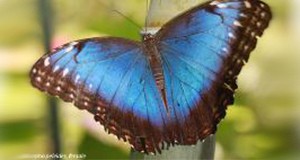
The blue morpho butterfly, also known as the peleides blue morpho or common blue morpho, is a brightly colored butterfly abundant in tropical environments in Central and South America. It can be seen flying in open areas such as paths, trails, forest edges, and rivers. In the United States, it is often featured in museums and zoos that have butterfly houses or butterfly rainforests. This five-page fact sheet about the popular butterfly was written by Haleigh A. Ray and Jacqueline Y. Miller and published by the UF Department of Entomology and Nematology, September 2015. (Photo credit: Andrei Sourakov, McGuire Center or Lepidoptera and Biodiversity, Florida Museum of Natural History, University of Florida)
http://edis.ifas.ufl.edu/in1101
Turfgrass Herbicides: Mechanisms of Action and Resistance Management
Herbicides are an effective tool for controling weeds in turfgrass; however, weeds can become resistant to herbicides and create significant problems for turfgrass production. The best way to combat herbicide resistance is to rotate herbicides with different mechanisms of action (MOA) because using herbicides with different MOAs makes it more likely that weeds resistant to one herbicide will encounter an herbicide to which they are not resistant. This 4-page fact sheet focuses on how to create an herbicide program that uses different MOAs to manage resistant weeds. Written by Ramon G. Leon and Bryan Unruh, and published by the UF Department of Agronomy, August 2015.
http://edis.ifas.ufl.edu/ag398
Estimated Water Savings Potential of Florida-Friendly Landscaping™ Activities
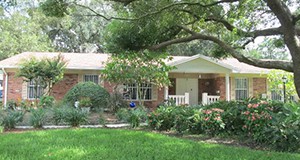
To help homeowners predict the impact of implementing some of the water conservation measures listed on Florida-Friendly Landscaping™ checklist, this 5-page fact sheet offers a table of estimated water savings. Homeowners can select activities which are the best fit for their landscape and can also see which have the most conservation potential. The water savings is compared to a baseline case of typical irrigation behavior. This 5-page fact sheet was written by Mackenzie Boyer and Michael Dukes, and published by the UF Department of Agricultural and Biological Engineering, August 2015. (Photo credit: Michael Gutierrez, UF/IFAS)
http://edis.ifas.ufl.edu/ae515
A Manual for the Design and Implementation of Teaching and Demonstration Gardens
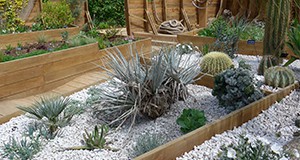
Teaching and demonstration gardens are places where the public can learn about different types of gardens and landscapes. This 10-page fact sheet discusses the various types of gardens, how to plan and develop a demonstration garden, logistical and design considerations, and educational programming. Written by Gail Hansen, and published by the UF Environmental Horticulture Department, July 2015.
http://edis.ifas.ufl.edu/ep524
Improving Weed Control in Landscape Planting Beds
Because landscape beds often contain a variety of ornamental plants, shrubs, and trees, using herbicides to control weeds in these areas can be challenging; however, non-herbicidal methods can be labor intensive. This 6-page fact sheet outlines how to use landscape design and cultural and chemical practices to effectively control weeds in landscape beds. This publication also discusses the use of pre- and postemergent herbicides. Written by Chris Marble and Andrew Koeser, and published by the UF Department of Environmental Horticulture, June 2015.
http://edis.ifas.ufl.edu/ep523
Golden Canna: Canna flaccida
Golden canna is a native wetland plant with bright yellow flowers that can be found throughout most of Florida. This 4-page facts sheet details the golden canna’s biology, distribution and habitat, propagation, pests and diseases, and landscaping and other uses. Written by Edward F. Gilman, Carl J. Della Torre III, and Lyn A. Gettys, and published by the UF Department of Environmental Horticulture, June 2015.
http://edis.ifas.ufl.edu/fp102
Contaminantes en el Medio Ambiente Urbano: Los Perfluoroalquilos
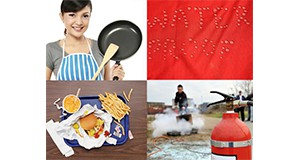 Los perfluoroalquilos–los perfluorocarbonos (PFC) o, en inglés, perfluoroalkyl substances (PFASs)–son los productos químicos artificiales más comunes y persistentes en el planeta. Algunos de los productos más comunes que contienen perfluoroalquilos son sartenes de teflón, utensilios de cocina antiadherente, chaquetas impermeables (como Gore-Tex), espumas de extinción de incendios, envases de alimentos, alfombras y telas para muebles. Los perfluoroalquilos poseen un largo tiempo de residencia en el medio ambiente, lo que significa que los perfluoroalquilos pueden acumularse en los organismos en niveles que causan efectos nocivos.
Los perfluoroalquilos–los perfluorocarbonos (PFC) o, en inglés, perfluoroalkyl substances (PFASs)–son los productos químicos artificiales más comunes y persistentes en el planeta. Algunos de los productos más comunes que contienen perfluoroalquilos son sartenes de teflón, utensilios de cocina antiadherente, chaquetas impermeables (como Gore-Tex), espumas de extinción de incendios, envases de alimentos, alfombras y telas para muebles. Los perfluoroalquilos poseen un largo tiempo de residencia en el medio ambiente, lo que significa que los perfluoroalquilos pueden acumularse en los organismos en niveles que causan efectos nocivos.
This 6-page fact sheet is the Spanish language version of Contaminants in the Urban Environment: Perfluoroalkyl Substances, written by Ignacio A. Rodriguez-Jorquera and Gurpal S. Toor, and published by the UF Department of Soil and Water Science, June 2015.
http://edis.ifas.ufl.edu/ss644
Feature image credit: iStock/Thinkstock.com (non-stick pan, waterproof fabric, and fire fighting foam)/Digital Vision/Thinkstock.com (fast food)
Adonidia merrillii: Christmas Palm
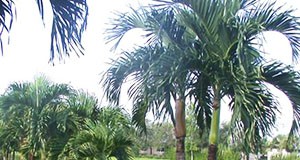
The Christmas palm (Adonidia merrillii) is a fast-growing palm that is well-suited for small sites, requires little maintenance, is relatively disease-free, and produces clusters of bright red fruit in winter, hence the common name Christmas palm. This 2-page fact sheet covers the Christmas palms biology, distribution and habitat, susceptibility to disease, and general care. Written by Timothy K. Broschat, and published by the UF Department of Environmental Horticulture, July 2015.
http://edis.ifas.ufl.edu/st658
Orchid Pollination Biology
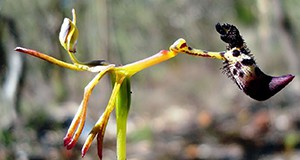
Orchids and their pollinators have developed fascinating co-adaptations that promote orchid pollination. This 6-page fact sheet details the various and often strange ways that orchids attract pollinators. The kinds of insects and animals that pollinate orchids and orchids’ reproductive anatomies and processes are also covered. Written by Haleigh Ray and Wagner Vendrame, and published by the UF Department of Environmental Horticulture, June 2015.
http://edis.ifas.ufl.edu/ep521
Spondias Growing in the Florida Home Landscape
Spondias species (whose common names among English speakers include ambarella, Ataheite apple, mombins, and hog plums) are flowering trees native to tropical and subtropical regions. They are known for their sweet fruit and grow well in the warmest parts of Florida. This 8-page fact sheet discusses biology, distribution and uses, as well as guidelines for propagation and maintenance. Written by Jonathan H. Crane and Jeffrey Wasielewski, and published by the UF Department of Horticultural Sciences, April 2015. (Photo by Forest & Kim Starr, CC BY 3.0)
http://edis.ifas.ufl.edu/mg059
A Sand Fly Lutzomyia longipalpis (Lutz and Neiva) (Insecta: Diptera: Psychodidae: Phlebotominae)
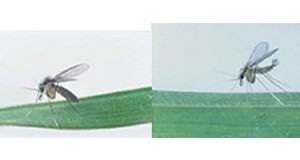 The true sand flies are densely covered with setae, have long slender legs, and broad and pointed wings that are held erect at rest. Several phlebotomine species are vectors of the protozoan parasites in the genus Leishmania, that are the causal agents of leishmaniasis. Visceral leishmaniais is the most severe form of the disease, and is fatal to the human or dog host if untreated. This 6-page fact sheet was written by Maria C. Carrasquilla and Phillip E. Kaufman, and published by the UF Department of Entomology and Nematology, June 2015. (Photo credit: Cristina Ferro, Instituto Nacional de Salud, Colombia
The true sand flies are densely covered with setae, have long slender legs, and broad and pointed wings that are held erect at rest. Several phlebotomine species are vectors of the protozoan parasites in the genus Leishmania, that are the causal agents of leishmaniasis. Visceral leishmaniais is the most severe form of the disease, and is fatal to the human or dog host if untreated. This 6-page fact sheet was written by Maria C. Carrasquilla and Phillip E. Kaufman, and published by the UF Department of Entomology and Nematology, June 2015. (Photo credit: Cristina Ferro, Instituto Nacional de Salud, Colombia
http://edis.ifas.ufl.edu/in1091
Vespiform Thrips Franklinothrips vespiformis Crawford (Insecta: Thysanoptera: Aeolothripidae)
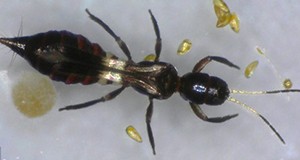
Franklinothrips vespiformis Crawford is a predatory thrips with a pantropical distribution. The distinctive red, humped-back larvae and fast-moving ant-like adults are predaceous on small arthropods. In addition to being easily mistaken for an ant, this beneficial thrips is unusual in that it constructs a silken cocoon within which it pupates. Males of this species are rare. This species is sold for use as a biological control agent in botanical gardens, zoos, interior landscapes, research greenhouses, nurseries with ornamental plants as well as outdoors in subtropical regions. This 4-page fact sheet was written by Runqian Mao, Yingfang Xiao, and Steven P. Arthurs, and published by the UF Department of Entomology and Nematology, March 2015. (Photo credit: Runqian Mao, UF/IFAS)
http://edis.ifas.ufl.edu/in1083
Black Scale Saissetia oleae (Olivier, 1791) (Insecta: Hemiptera: Coccoidea: Coccidae)
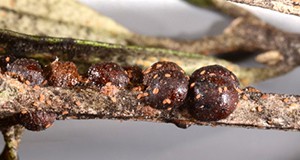 The black scale is an important pest of citrus and olive trees. Originally from South Africa, this scale is now distributed worldwide. In Florida, black scale is found on citrus, cultivated olive, avocado, and many popular landscape plants. It is likely that black scale, like many invasive pests, was imported to the United States on infested nursery plants. Based on their small size and the unique life history of scale insects, these insects are difficult to detect and control. This 4-page fact sheet was written by Morgan A. Byron, Jennifer L. Gillett-Kaufman, and Sandra A. Allan, and published by the UF Department of Entomology and Nematology, March 2015. (Photo credit: Lyle Buss, UF/IFAS)
The black scale is an important pest of citrus and olive trees. Originally from South Africa, this scale is now distributed worldwide. In Florida, black scale is found on citrus, cultivated olive, avocado, and many popular landscape plants. It is likely that black scale, like many invasive pests, was imported to the United States on infested nursery plants. Based on their small size and the unique life history of scale insects, these insects are difficult to detect and control. This 4-page fact sheet was written by Morgan A. Byron, Jennifer L. Gillett-Kaufman, and Sandra A. Allan, and published by the UF Department of Entomology and Nematology, March 2015. (Photo credit: Lyle Buss, UF/IFAS)
http://edis.ifas.ufl.edu/in1082
Black Turpentine Beetle, Dendroctonus terebrans (Olivier) (Insecta: Coleoptera: Curculionidae: Scolytinae)
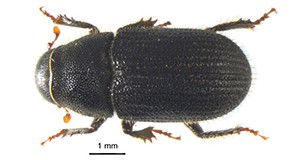 Black turpentine beetles bore into the inner bark of stressed or injured pines, where they breed and feed on phloem tissue. Adults are strongly attracted to volatile pine odors and readily breed in fresh stumps. In typical forests, infestations do not exhibit the rapid and devastating expansion characteristic of the closely related southern pine beetle, but in stands where stress conditions are frequent or persistent, black turpentine beetle can become a chronic pest and cause significant mortality over an extended period of time. Historically, black turpentine beetle has been a major pest of pines wounded or treated with herbicides in naval stores production. During the 1950s, black turpentine beetle damaged 37 million board feet of timber and contributed to the financial collapse of turpentine farms. This 5-page fact sheet was written by Albert E. Mayfield, John L. Foltz and Jiri Hulcr, and published by the UF Department of Entomology and Nematology, June 2015. (Photo credit Adam Black and Jiri Hulcr, UF/IFAS)
Black turpentine beetles bore into the inner bark of stressed or injured pines, where they breed and feed on phloem tissue. Adults are strongly attracted to volatile pine odors and readily breed in fresh stumps. In typical forests, infestations do not exhibit the rapid and devastating expansion characteristic of the closely related southern pine beetle, but in stands where stress conditions are frequent or persistent, black turpentine beetle can become a chronic pest and cause significant mortality over an extended period of time. Historically, black turpentine beetle has been a major pest of pines wounded or treated with herbicides in naval stores production. During the 1950s, black turpentine beetle damaged 37 million board feet of timber and contributed to the financial collapse of turpentine farms. This 5-page fact sheet was written by Albert E. Mayfield, John L. Foltz and Jiri Hulcr, and published by the UF Department of Entomology and Nematology, June 2015. (Photo credit Adam Black and Jiri Hulcr, UF/IFAS)
http://edis.ifas.ufl.edu/in636
Dagger Nematode Xiphinema spp. (Cobb, 1913) Inglis, 1983 (Nematoda: Enoplea: Dorylaimia: Dorylaimina: Xiphinematinae)
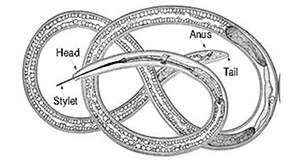
Dagger nematodes parasitize plants. They cause economic damage and death of host crops through feeding on the roots and by spreading viral mosaic and wilting diseases, but field studies have shown that some control measures targeting reduction in the population of dagger nematodes can be effective in controlling viral diseases in susceptible crops. This 7-page fact sheet was written by William K. Heve, William T. Crow, and Tesfamarian Mengistu, and published by the UF Department of Entomology and Nematology, June 2015.
http://edis.ifas.ufl.edu/in1097
Skyflower: Hydrolea corymbosa
Skyflower is a native wetland plant that produces brilliant blue flowers and can be found throughout Florida. This 4-page facts sheet details skyflower biology, distribution and habitat, propagation, and uses. Written by Lyn A. Gettys and Carl J. Della Torre III, and published by the UF Department of Agronomy, July 2015.
http://edis.ifas.ufl.edu/ag397
Contaminants in the Urban Environment: Dioxins
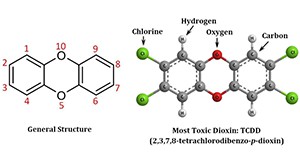 Dioxins are among the most toxic chemicals on the earth. They are by-products of a number of human activities such as combustion of fuels and wastes containing polyvinyl chloride (PVC), chlorine bleaching of paper products, and selected industrial processes. Current releases of dioxins by humans are due to the combustion of fuels and burning of household trash. The good news is that levels of dioxins in the environment have decreased in the United States throughout the past 30 years due to the improved emission controls and regulatory activities. But dioxins break down slowly, so they remain in the environment for a long time and accumulate in the food chain. Long-term exposure to dioxins can harm immune system, nervous system, endocrine system, and reproductive functions. This 7-page fact sheet discusses the sources, emission trends, and impacts of dioxins as well as the ways to minimize exposure to dioxins. Written by Yun-Ya Yang and Gurpal S. Toor, and published by the UF Department of Soil and Water Science, July 2015.
Dioxins are among the most toxic chemicals on the earth. They are by-products of a number of human activities such as combustion of fuels and wastes containing polyvinyl chloride (PVC), chlorine bleaching of paper products, and selected industrial processes. Current releases of dioxins by humans are due to the combustion of fuels and burning of household trash. The good news is that levels of dioxins in the environment have decreased in the United States throughout the past 30 years due to the improved emission controls and regulatory activities. But dioxins break down slowly, so they remain in the environment for a long time and accumulate in the food chain. Long-term exposure to dioxins can harm immune system, nervous system, endocrine system, and reproductive functions. This 7-page fact sheet discusses the sources, emission trends, and impacts of dioxins as well as the ways to minimize exposure to dioxins. Written by Yun-Ya Yang and Gurpal S. Toor, and published by the UF Department of Soil and Water Science, July 2015.
http://edis.ifas.ufl.edu/ss642
